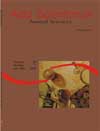Produção de matéria seca e fluxo de tecidos de <em>Cynodon spp</em>. cv. Tifton 85 em resposta a doses de nitrogênio
Resumo
Foram determinados a produção de matéria seca (PMS) e o fluxo de tecidos do capim-Tifton 85 (Cynodon spp.) sob efeito de quatro doses de nitrogênio (N0-0, N1-45, N2-90, N3-135 mg/kg de solo) na forma de nitrato de amônio, delineadas inteiramente ao acaso, com 5 repetições. Verificou-se aumento (p < 0,05), apenas, na PMS de folhas e colmos em resposta às doses de nitrogênio. A PMS de folhas apresentou comportamento quadrático, porém sem atingir a máxima produção com as doses utilizadas, enquanto que PMS de colmo atingiu o ponto de máxima com 133,5 mg/kg. Quanto ao fluxo de tecidos, nas doses mais elevadas de N, ocorreram as maiores taxas de alongamento de folhas (Tal), aparecimento de folhas (Tap) e número de folhas vivas por perfilho (p < 0,05). A taxa de senescência foliar (Tse) foi mais elevada para a testemunha (p < 0,05), enquanto que para o número de perfilhos/planta não houve resposta aos tratamentos de N (p > 0,05). Para a máxima PMS de folhas do capim-Tifton 85, seria necessária dose maior que as utilizadas, enquanto que para o colmo esse ponto foi atingido com 133,5 mg N/kg. A dose 135 mg N/kg teve maior influência no fluxo de tecidos da planta. A Tal e o número de folhas vivas por perfilho (NFVP) foram melhor correlacionados com a produção de matéria seca. Uma baixa Tse é de fundamental importância para a manutenção de um elevado NFVP. O teor de PB do capim-Tifton 85 apresentou maiores valores quando do uso de 135 mg N/kg de solo.Downloads
DECLARAÇÃO DE ORIGINALIDADE E DIREITOS AUTORAIS
Declaro que o presente artigo é original, não tendo sido submetido à publicação em qualquer outro periódico nacional ou internacional, quer seja em parte ou em sua totalidade.
Os direitos autorais pertencem exclusivamente aos autores. Os direitos de licenciamento utilizados pelo periódico é a licença Creative Commons Attribution 4.0 (CC BY 4.0): são permitidos o compartilhamento (cópia e distribuição do material em qualqer meio ou formato) e adaptação (remix, transformação e criação de material a partir do conteúdo assim licenciado para quaisquer fins, inclusive comerciais.
Recomenda-se a leitura desse link para maiores informações sobre o tema: fornecimento de créditos e referências de forma correta, entre outros detalhes cruciais para uso adequado do material licenciado.








































